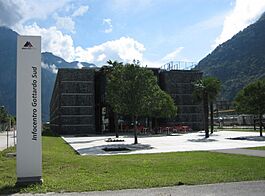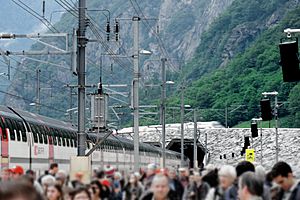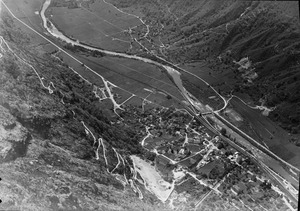Bodio facts for kids
Quick facts for kids
Bodio
|
||
|---|---|---|

Visitors center of the Gotthard Base Tunnel in Bodio-Pollegio
|
||
|
||
| Country | Switzerland | |
| Canton | Ticino | |
| District | Leventina | |
| Area | ||
| • Total | 6.48 km2 (2.50 sq mi) | |
| Elevation | 321 m (1,053 ft) | |
| Population
(Dec 2020 )
|
||
| • Total | 937 | |
| • Density | 144.60/km2 (374.5/sq mi) | |
| Postal code |
6743
|
|
| Surrounded by | Giornico, Personico, Pollegio, Semione, Sobrio | |
Bodio is a small town, also called a municipality, located in the Leventina district. It is part of the canton of Ticino in Switzerland.
Contents
History of Bodio
Bodio was first mentioned in official records in 1227. In the Middle Ages, Bodio and a nearby village called Simbra (which no longer exists) were part of an area known as a Degagna in Giornico. This was a local administrative division.
During the time when the cathedral of Milan ruled over three valleys, important meetings called placita della Leventina were held in Bodio. These meetings were for administering justice and discussing local issues in the Leventina valley.
Until the 16th century, Bodio belonged to the parish of Giornico. A parish is like a church district. Bodio became its own separate parish in 1567. The church of S. Stefano was first mentioned in 1227. Sadly, a landslide in the 15th century destroyed a large part of the village, including the church. The current parish church was built in the 19th century, and its bell tower dates back to 1779.
Bodio has faced several natural disasters. Floods in 1817, 1829, 1834, and 1839 caused a lot of damage. A big flood of the Ticino river in 1868 was even worse, causing 18 deaths and destroying homes.
Timber Transport and Emigration
Bodio was once important for moving timber (wood) along the Ticino river. Logs were floated freely down the river until they reached Bodio. Here, they were gathered and tied together to form rafts. This helped prevent damage to the riverbanks further downstream.
Many people from Bodio left the town to find work. Before the mid-1800s, most went to Italy. However, some families, like the Glaser and Ofensetzer families, often went to France. By 1876, about one-fifth of Bodio's population (which was 400 people at the time) had moved to the United States, mainly to California and Nevada.
From Farming to Industry

Bodio changed from a farming village to an industrial center because of two main things:
- The building of the Gotthard railway in the late 1800s.
- The use of water power from the Ticino river, starting in 1911 with the Biaschina-Zentrale power plant.
Having lots of cheap energy and good transport (the train) encouraged many factories to open in Bodio. This made the area an important industrial hub in Ticino. Around 1910, Swiss and German companies opened factories. These included Diamant (making grinding materials), Gotthardwerke (metal alloys), Nitre (a chemical plant), and two carbide factories. These factories employed over 1,000 workers, many of whom were from Italy. They did very well during World War I because they produced explosive materials.
After the war, the industry faced challenges, and some factories closed. For example, the granite industry, which employed about 150 people, collapsed. On July 21, 1921, there was a big explosion at the Nitre chemical plant. It killed 15 people, destroyed the factory, and damaged nearby buildings.
The growth of industry also led to the creation of trade unions. These are groups that protect workers' rights. In 1917, Bodio became home to the first local section of the metal workers union (SMUV).
Over the years, some companies changed hands or closed. For example, Gotthardwerke was bought by Lonza in 1924 and later renamed Timcal in 1995. This company became a world leader in making synthetic graphite. Another well-known local company was Monteforno, which made steel. It was founded in 1946 and closed in 1995.
Today, there are no longer any farms in Bodio. However, there are about 4 acres of land used for growing wine grapes, which produce good quality Merlot wine.
Geography of Bodio
Bodio covers an area of about 6.44 square kilometers (2.49 sq mi).
- About 5.9% of this land is used for farming.
- A large part, 66.0%, is covered by forests.
- About 11.8% of the land has buildings or roads.
- A small portion, 1.9%, is rivers or lakes.
- The remaining 15.2% is unproductive land, meaning it cannot be used for farming or building.
The town is located in the Leventina district, at an elevation of 321 meters (1,053 ft). It sits on the left side of the lower Leventina valley.
Coat of Arms
The blazon (description) of Bodio's municipal coat of arms is: Per bend sinister Gules a cross Argent and Or a mullet of the first. This means it has a diagonal line from top left to bottom right. The top left part is red with a silver cross. The bottom right part is gold with a red star.
Population of Bodio
Bodio has a population of about 976 people (as of 2023). About 43.3% of the people living in Bodio are foreign nationals. Over the last 10 years, the population has decreased by about 12.7%.
Languages Spoken
Most people in Bodio (about 87.1%) speak Italian. This is one of Switzerland's national languages. Other languages spoken include Serbo-Croatian (3.4%) and Portuguese (2.5%). In 2000, 13 people spoke German and 8 people spoke French.
Age Groups
Looking at the age groups in 2009:
- About 7.7% of the population were children aged 0-9 years old.
- About 9.2% were teenagers aged 10-19.
- About 10.3% were young adults aged 20-29.
- About 13.4% were adults aged 30-39.
- About 16.4% were adults aged 40-49.
- About 14.9% were adults aged 50-59.
- About 12.9% were seniors aged 60-69.
- About 7.8% were seniors aged 70-79.
- About 7.5% were over 80 years old.
Historical Population
Here's how Bodio's population has changed over time:
| year | population |
|---|---|
| 1354 | 32 Hearths |
| 1567 | 50 |
| 1602 | 201 |
| 1745 | 323 |
| 1850 | 362 |
| 1880 | 420 |
| 1900 | 356 |
| 1950 | 935 |
| 1980 | 1,477 |
| 1990 | 1,154 |
| 2000 | 1,058 |
Important Buildings
The Centrale Idroelettrica Della Biaschina (Hydroelectric power plant at Biaschina) is a very important building in Switzerland. It is listed as a heritage site of national significance.
Economy and Work

In 2007, Bodio had an unemployment rate of 5.12%. This means about 5 out of every 100 people looking for work couldn't find a job.
In 2005, there were:
- 6 people working in the primary economic sector (like farming or fishing).
- 256 people working in the secondary sector (like manufacturing and factories).
- 119 people working in the tertiary sector (like services, shops, and offices).
Many people who live in Bodio travel to other towns for work. In 2000, 285 people commuted away from Bodio for their jobs. At the same time, 331 workers came into Bodio from other places. This means Bodio has more jobs than local workers. Most people (60.8%) use a private car to get to work, while 9.1% use public transportation.
As of 2009, Bodio had 3 hotels with a total of 48 rooms and 87 beds for visitors.
Religion
Based on the 2000 census:
- About 79.9% of the people in Bodio were Roman Catholic.
- About 1.6% belonged to the Swiss Reformed Church.
- About 12.76% belonged to other churches not listed in the census.
- About 5.77% did not answer the question about their religion.
Education
Switzerland has a good education system. In Bodio, about 49.5% of adults (aged 25–64) have completed either high school or higher education, like university.
In 2009, there were 148 students in Bodio.
- The Ticino education system offers up to three years of non-mandatory kindergarten. In Bodio, 26 children were in kindergarten.
- Primary school lasts for five years. In Bodio, 48 students attended standard primary schools, and 5 students attended a special school.
- For middle school, students either go to a two-year middle school followed by a two-year pre-apprenticeship program, or a four-year program to prepare for higher education. There were 30 students in the two-year middle school and 3 in their pre-apprenticeship. 5 students were in the four-year advanced program.
- After middle school, students can choose different paths. Some go to vocational schools to learn a trade. In Bodio, 12 students were attending vocational school full-time, and 17 part-time.
- There were also 2 students in a professional program, which prepares them for jobs in fields like engineering or nursing.
In 2000, 4 students from other towns came to school in Bodio, while 74 students from Bodio went to schools outside the municipality.
Transport
Bodio has a railway station on the Gotthard railway line. However, trains do not stop there very often.
See also
 In Spanish: Bodio para niños
In Spanish: Bodio para niños





